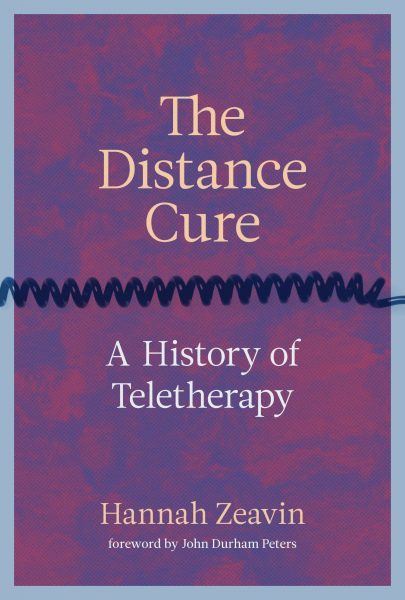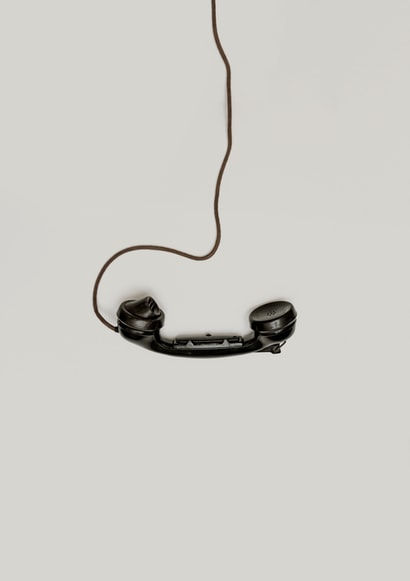Charlie Williams: Hi Hannah, your brilliant book The Distance Cure: A History of Teletherapy came out with MIT Press in August. Can you tell us what you mean by teletherapy and how you came to the subject?
Hannah Zeavin: Thanks so much, Charlie. Sure — let me flip those questions. I wanted to write a book that brought together my interests in information science and the history of technology with my long-term investment in mental health care and its histories.
I had a sort of additive thought: what about the history of mediated therapy? I thought of mediated therapy as a wonderful aperture onto questions of the virtual and the real, and the role technology plays in our most intimate relationships. But as I began to write, the book took on a key argument: all therapy is indeed mediated, comprised not of a dyad (a patient(s) and a therapist) but a triad, comprised of patient, therapist, and media.
I argue that from the moment Freud stopped laying his hands on his patients as part of hypnosis, distance has always been involved in psychotherapies. The question has been whether these distances are overt and literalised, and what patients and clinicians alike have made of them. And that’s where I delimited to teletherapy: the use of telecommunications to span that distance.
I write extensively about pre-cursors to true teletherapy – Freud’s use of letter writing and the postal system for instance. I then proceed through chapters on ‘mass intimacy’ in the broadcast form, the ‘intimate stranger’ in the case of the 1950s suicide hotline, ‘auto-intimacy’ with AI agents, and e-therapy. Although the book was complete at the start of the pandemic, my editor graciously allowed me to add a Coda, ‘When Distance Is Everywhere’. Here I discuss the COVID-19 pandemic, which turned teletherapy, therapy’s shadow form, into the dominant if not exclusive mode of mental healthcare in much of the world.

CW: The Distance Cure begins somewhat surprisingly with Freud. What was his relationship to distanced therapy and did he theorise it at all?
HZ: So this was something that surprised me. Until pretty recently, theorisation of teletherapy was quite minor. In the 1980s there were a few articles by psychoanalysts on phone sessions, and recently, there has been clinical work on screen therapy (Skype, now Zoom). But very few people have taken up media theory and theories of the consulting room to think about teletherapy and relationships experienced in that practice.
It is well-known that Freud loved to explain and metaphorise psychoanalytic concepts via media: memory is like a mystic writing pad, the dream is like a censor, analytic listening is like a telephone call. In parallel, Freud was making active use of media to deliver (and to receive) analytic care at a distance. One of his best-known cases, the case of ‘Little Hans’, was conducted almost entirely by letter. My opening chapter shows how in his letters, Freud tries to diminish the intrusiveness of the distance that is imposed by the form. I have a long theorisation of why that might be, drawing on Freud’s own fantasies about immediate modes of communication, like telepathy—which haunts the whole book. I argue that there is a suppression of mediation in the supposedly ‘pure’ in-person scenario, which is part and parcel with Freud (and others) attempts to keep charges of charlatanism at bay; curiously this convention has been long standing and widely adopted.
CW: You write that teletherapy is ‘often the emergency room of mental health care’. How can teletherapy respond to moments of individual and social crisis that other therapies cannot?
HZ: In my research I was surprised to see that, time and time again, teletherapy is innovated in, and attends, crisis. That means that for those who cannot access these media, telecare can produce new structural harms, even as it is commonly escorted by a democratising promise.
At the same time, the modes of interaction available in the history of teletherapy—and here I am specifically thinking about peer-based care in the 1950s on the crisis hotline – re-enfold many who might otherwise be unable (or not want) to access professional care.
So I think a lot about the power relations in the consulting room, outside the consulting room, infrastructures that codify and produce those dynamics, and the creative and generative ways activists have undone or upended them.

CW: The title of your book has a double meaning. It’s a history of therapy at a distance but you’re also continuously interrogating the therapeutic role of distance and mediated communication. How did you interpret distance as both a barrier and a goal of therapy?
HZ: Thanks so much for that Charlie—that’s exactly right. The book argues that we can actually recast the history of therapy by way of its shadow form, teletherapy, across the 20th century. This makes a number of interventions as to questions of therapeutic labor, patient experience, as well as activist and community-based care.
At the same time, the book is in no way evangelising teletherapy. Instead, I wanted to bracket the assumption that distance is equivalent to absence; it isn’t.
Sometimes the therapies I study in this book are harmful; sometimes they’re radical scenes of care. Time after time I read case material where it was clear that a patient would only be reachable if some sort of distance could be used to overcome their isolation. As just one example, in the emergence of cyber mental health clinics in the 1990s, patients could not bear to come in, in person (let alone those who couldn’t access normative therapeutic care for other reasons)—so they found licensed psychiatrists and psychologists who would truly meet them where they were: online. One of these patients finally came in for a session, at her therapist’s urging, as I detail in the book. After years of intimate digital contact, facing each other in the room left the patient unable to do the work; they moved back to digital treatment immediately.
CW: The Distance Cure proved to be incredibly timely as the pandemic forced therapists from across the world to explore the possibilities of therapy via screen. How did you find clinicians responded to this moment?
HZ: The timing was strange; the whole book was written and just through peer review as lock down happened. I address the pandemic in the Coda. Some clinicians really focused on Zoom fatigue; they just hated it. But many noted that they were shocked at the additional forms of intimacy—verging on telepathy—that distance therapy allowed. Some of this was really material. Pandemic conditions with Zoom meant that many were doing childcare, in their living rooms, while in session or else taking their phone sessions in bathrooms or cars. So therapists necessarily saw a lot more, beyond the traditional frame because Zoom of course enforces its own norms of looking; when video is in use the patient (and therapist) are in a perpetual close-up so the face is much more clearly visible. Let alone what else enters the frame. And many patients saw or heard this extra-therapeutic information as well. But let us not forget, not all therapy is done in private practice and much of it cannot be moved to Zoom completely. This posed problems for inpatient therapy and other congruent settings, too.
CW: The therapeutic encounter has traditionally provided a useful space for thinking about relationality more broadly. How does your study of the teletherapeutic encounter challenge our preconceptions of mediated relationships?
HZ: That was one of the aims of the book, certainly. I understand the therapeutic relationship to be an ‘as-if’ relationship. It is a relationship that is extraordinary because it is the site of recapitulating and (one hopes) working through what has been put into oneself via these earlier other relationships. Yet it is also ordinary, because this is the condition of all relationships, elaborated across time, etc. So again, I was interested in distance as pharmakon, both the cause for ‘illness’ and the ‘cure’. Indeed, medium specific forms of relating come about, which I call genres of distanced intimacy. I wanted to bracket this assumption that teletherapy must be hopelessly lesser for being technologised. In uncovering this history, it turns out that it certainly is not lesser, but configured quite differently. Teletherapy has been an important tool, in many contexts, over the last 120 years or so.
Hannah Zeavin (@HZeavin) is a Lecturer in the Departments of English and History at the University of California, Berkeley. Her first book, The Distance Cure: A History of Teletherapy was published by MIT Press in August 2021. She is working on her second book, Mother’s Little Helpers: Technology in the American Family (MIT Press, 2023).